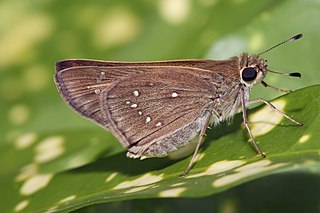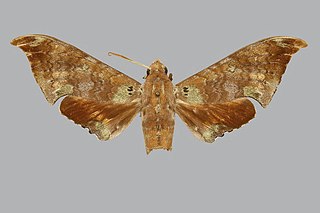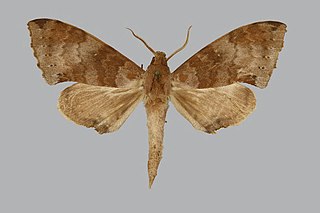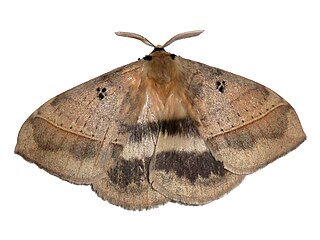
Skippers are a family, Hesperiidae, of the Lepidoptera. Being diurnal, they are generally called butterflies. They were previously placed in a separate superfamily, Hesperioidea; however, the most recent taxonomy places the family in the superfamily Papilionoidea. They are named for their quick, darting flight habits. Most have the antenna tip modified into a narrow hook-like projection. More than 3500 species of skippers are recognized, and they occur worldwide, but with the greatest diversity in the Neotropical regions of Central and South America.

Nepticulidae is a family of very small moths with a worldwide distribution. They are characterised by eyecaps over the eyes. These pigmy moths or midget moths, as they are commonly known, include the smallest of all living moths, with a wingspan that can be as little as 3 mm in the case of the European pigmy sorrel moth, but more usually 3.5–10 mm. The wings of adult moths are narrow and lanceolate, sometimes with metallic markings, and with the venation very simplified compared to most other moths.
The dwarf free-tailed bat is a species of bat in the family Molossidae. It is found in Cameroon, Democratic Republic of the Congo, Ivory Coast, Ethiopia, Ghana, Guinea, Kenya, Nigeria, Sierra Leone, South Sudan, and Uganda. Its natural habitats are subtropical or tropical dry forests and subtropical or tropical moist lowland forests. It is threatened by habitat loss.

The Trevor's free-tailed bat is a species of bat in the family Molossidae. It is found in Central African Republic, Democratic Republic of the Congo, Ivory Coast, Ghana, Guinea, Nigeria, South Sudan, and Uganda. Its natural habitats are subtropical or tropical dry forests and moist savanna. It is threatened by habitat loss.
Nacliodes is a genus of moths in the family Erebidae. It contains the single species Nacliodes microsippia, which is found in Angola, Cameroon, the Democratic Republic of Congo, Equatorial Guinea and Uganda.
Biareolifera is a genus of moths of the Noctuidae family. It contains only one species, Biareolifera geometriformis, which is found in Cameroon, the Democratic Republic of Congo (Orientale), Ghana and Nigeria.
Crobylophanes is a genus of moth in the family Cosmopterigidae. It contains only one species, Crobylophanes sericophaea, which is found in Democratic Republic of Congo.
Uranometra is a genus of moths belonging to the subfamily Drepaninae. It contains the single species Uranometra oculata, which is found in Cameroon, the Central African Republic, the Democratic Republic of Congo, Gabon, Ghana, Ivory Coast, Nigeria, Togo and Uganda.

Polyptychus enodia is a moth of the family Sphingidae. It is known from Gabon and the Congo Republic.

Polyptychus hollandi is a moth of the family Sphingidae. It is known from forests from Nigeria to the Congo.
Phylloxiphia goodii is a moth of the family Sphingidae. It is known from Sierra Leone, Liberia, Cameroon, the Central African Republic, Gabon, the Democratic Republic of the Congo and the Republic of the Congo.
Louis Beethoven Prout (1864–1943) was an English entomologist and musicologist.

Euriphene rotundata is a butterfly in the family Nymphalidae. It is found in the Democratic Republic of the Congo (Uele).
Amerila mulleri is a moth of the subfamily Arctiinae. It was described by Häuser and Boppre in 1997. It is found in the Democratic Republic of Congo, Kenya, Swaziland and Zimbabwe.
Ancylolomia capensis is a species of moth in the family Crambidae. this species is known from central, eastern and southern Africa.

Chrysotypus medjensis is a species of moth of the family Thyrididae. It is found in the Democratic Republic of the Congo.

Archichlora phyllobrota is a species of moth of the family Geometridae. It is found in central Africa and it is known from Gabon, Cameroon and Congo.
Rhipidarctia invaria is a moth in the family Erebidae. It was described by Francis Walker in 1856. It is found in Angola, Cameroon, the Republic of the Congo, the Democratic Republic of the Congo, Gabon, Ivory Coast, Nigeria, Sierra Leone, Tanzania and Uganda.

Jana eurymas, the banded monkey, is a moth in the family Eupterotidae. It was described by Gottlieb August Wilhelm Herrich-Schäffer in 1854. It is found in Cameroon, the Republic of the Congo, the Democratic Republic of the Congo, Ghana, Guinea, Kenya, Namibia, Sierra Leone, South Africa, Tanzania and Zambia.
Janomima mariana, the inquisitive monkey, is a moth in the family Eupterotidae first described by Adam White in 1843. It is found in the Democratic Republic of the Congo, Eritrea, Mozambique, Rwanda, South Africa, Tanzania, Zambia and Zimbabwe.











